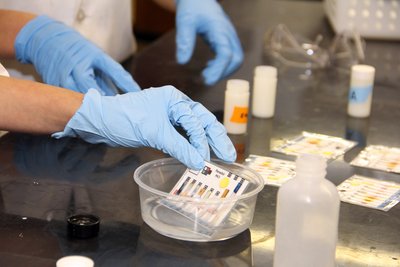Paper-based tool can screen for counterfeit drugs
The World Health Organization estimates that 10-30% of the drug supply in developing countries consists of counterfeit medicines, causing hundreds of thousands of deaths each year. Officials blame crime rings, which profit from selling pills that contain plaster of Paris, baking soda or other inexpensive ingredients.
In the US, a Saint Mary’s College chemistry research team has developed an inexpensive paper-based tool that can screen for counterfeit pain relievers. The paper analytical device (PAD) is the size of a business card and offers results in less than five minutes. It is technology that could ferret out other fake drugs that promise cures for everything from malaria to the flu. Counterfeit pharmaceuticals are a serious problem in developing countries.
Undergraduate researchers modified existing paper-strip technology to develop PADs that screen for substandard tablets of Panadol. Panadol is one of multiple brand names used abroad for the pain and fever reliever acetaminophen.
“Panadol long has been among the most common, standard pain-relieving drugs counterfeited around the world,” said Saint Mary’s chemistry professor Toni Barstis, who led the team. “In the past, you could just look at the labelling and packaging and know if it was counterfeit. Now, they do such a good job with the package design it’s hard to determine whether it’s a package of the genuine medicine or a fake that contains no acetaminophen or even ingredients that may be harmful.”
The tool that Barstis’s team developed uses a chemically treated paper that resembles a business card. To check for counterfeit ingredients, a person simply swipes the pill onto the PAD and dips the PAD in water. Colour changes on the paper indicate both suspicious and authentic ingredients. The screening takes less than five minutes and can be done by consumers. This lies in stark contrast to high-tech analytical methods, which are expensive and time-consuming. For instance, instrumental testing of pharmaceuticals in labs in Kenya can take 3-6 months. Precious time can be lost as a patient waits for treatment.

Barstis said the counterfeit acetaminophen products are just the tip of the iceberg. Other fake pharmaceuticals are marketed as cures for infections, malaria and the flu. Some contain acetaminophen, which reduces pain and fever, but do not contain the active ingredient to combat these diseases. Because the Panadol PAD checks for the presence of acetaminophen, it can be modified to screen the other drugs. Barstis’s team - in collaboration with chemistry, biochemistry, computer science and industrial design teams at the University of Notre Dame - is developing similar tools to identify counterfeit antibiotics, anti-malaria drugs and Tamiflu, the influenza medication.
Blood test could be used to diagnose Parkinson's earlier
Researchers have developed a new method that requires only a blood draw, offering a non-invasive...
Cord blood test could predict a baby's risk of type 2 diabetes
By analysing the DNA in cord blood from babies born to mothers with gestational diabetes,...
DNA analysis device built with a basic 3D printer
The Do-It-Yourself Nucleic Acid Fluorometer, or DIYNAFLUOR, is a portable device that measures...





